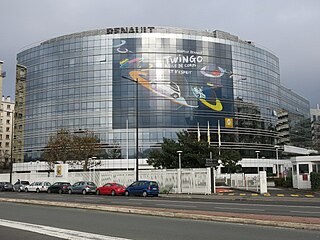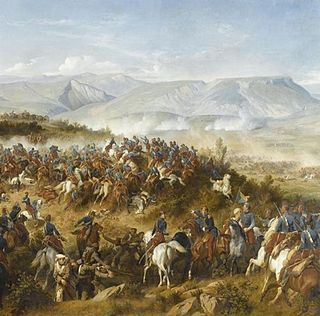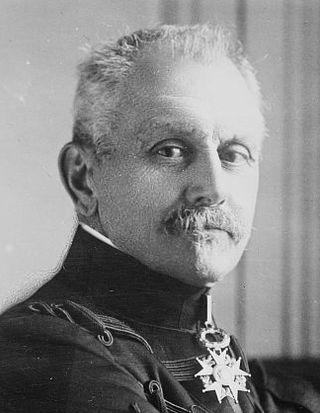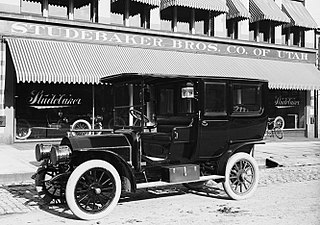
The Second Battle of the Marne was the last major German offensive on the Western Front during the First World War. The attack failed when an Allied counterattack, supported by several hundreds of tanks, overwhelmed the Germans on their right flank, inflicting severe casualties. The German defeat marked the start of the relentless Allied advance which culminated in the Armistice with Germany about 100 days later.

Groupe Renault is a French multinational automobile manufacturer established in 1899. The company produces a range of cars and vans and in the past, has manufactured trucks, tractors, tanks, buses/coaches, aircraft and aircraft engines, and autorail vehicles.

The First Battle of the Marne was a battle of the First World War fought from 5 to 12 September 1914. The German army invaded France with a plan for winning the war in 40 days by occupying Paris and destroying the French and British armies (Allies/Entente). The Germans had initial successes in August. They were victorious in the Battles of Mons and the Frontiers and overran a large area of northern France and Belgium. In what is called the Great Retreat the Germans pursued the retreating Franco/British forces more than 250 km (160 mi) southward. The French and British halted their retreat in the Marne River valley while the Germans advanced to 40 km (25 mi) from Paris.

The Renault FT was a French light tank that was among the most revolutionary and influential tank designs in history. The FT was the first production tank to have its armament within a fully rotating turret. The Renault FT's configuration became and remains the standard tank layout. Consequently, some armoured warfare historians have called the Renault FT the world's first modern tank.

The Chasseurs d'Afrique were a light cavalry corps of chasseurs in the French Armée d'Afrique. First raised in 1831 from regular French cavalry posted to Algeria, they numbered five regiments by World War II. For most of their history they were recruited from either French volunteers or French settlers in North Africa doing their military service. As such they were the mounted equivalent of the French Zouave infantry. The other major cavalry element in the Armee d'Afrique were the Spahis—recruited from the indigenous peoples of Algeria, Tunisia, and Morocco with mostly French officers.

Louis Renault was a French industrialist, one of the founders of Renault, and a pioneer of the automobile industry.

Michel-Joseph Maunoury was a commander of French forces in the early days of World War I who was posthumously elevated to the dignity of Marshal of France.

Paris is the centre of a national, and with air travel, international, complex transport system. The modern system has been superimposed on a complex map of streets and wide boulevards that were set in their current routes in the 19th century. On a national level, it is the centre of a web of road and railway, and at a more local level, it is covered with a dense mesh of bus, tram and metro service networks.

Industrias Kaiser Argentina S.A. was an Argentine automobile manufacturer established in 1956 as a joint venture with Kaiser Motors of the United States. Headquartered in Santa Isabel, Córdoba, the automaker produced a variety of Kaiser Jeep vehicles and American Motors Corporation (AMC) models, including Argentina's most iconic car, the Torino, before partnering with France's Renault, which bought it out in 1970.
The A.M. was a range of automobiles manufactured by the French firm of Ateliers Veuve A. de Mesmay. The vehicles were produced in Saint-Quentin, Aisne, France, from 1906 to 1914 and marketed under the name Automobiles 'Abeille' de Mesmay. They were powered by petrol engines of various sizes made by the de Mesmay firm, all marketed under the 'Abeille' (En:'Bee') trade name. The same engines and chassis were used in the AML and AMC range of commercial vehicles.

A taxi, also known as a taxicab or simply a cab, is a type of vehicle for hire with a driver, used by a single passenger or small group of passengers, often for a non-shared ride. A taxicab conveys passengers between locations of their choice. This differs from public transport where the pick-up and drop-off locations are decided by the service provider, not by the customers, although demand responsive transport and share taxis provide a hybrid bus/taxi mode.

A limousine, or limo for short, is a large, chauffeur-driven luxury vehicle with a partition between the driver compartment and the passenger compartment which can be operated mechanically by hand or by a button electronically. A luxury sedan with a very long wheelbase and driven by a professional driver is called a stretch limousine.

During World War I, France was one of the Triple Entente powers allied against the Central Powers. Although fighting occurred worldwide, the bulk of the French Army's operations occurred in Belgium, Luxembourg, France and Alsace-Lorraine along what came to be known as the Western Front, which consisted mainly of trench warfare. Specific operational, tactical, and strategic decisions by the high command on both sides of the conflict led to shifts in organizational capacity, as the French Army tried to respond to day-to-day fighting and long-term strategic and operational agendas. In particular, many problems caused the French high command to re-evaluate standard procedures, revise its command structures, re-equip the army, and to develop different tactical approaches.

The Battle of Grand Couronné from 4 to 13 September 1914, took place in France after the Battle of the Frontiers, at the beginning of the First World War. After the German victories of Sarrebourg and Morhange, pursuit by the German 6th Army and the 7th Army, took four days to regain contact with the French and attack to break through French defences on the Moselle.

Corre La Licorne was a French car maker founded 1901 in Levallois-Perret, at the north-western edge of central Paris, by Jean-Marie Corre. Cars were produced until 1947.

RCI Banque SA, trading as Mobilize Financial Services, is a France-based international company that is a wholly owned subsidiary of Renault and part of Renault's Mobilize unit. RCI Banque specialises in automotive financing, insurance, and related activities for the Renault group brands globally for the Nissan group brands in Europe, Russia, Asia and South America; and for Mitsubishi Motors in the Netherlands.

Renault Classic is a department within the Marketing and Communications Branch of the French automobile brand Renault. This department preserves, renovates and exhibits historical Renault vehicles. Until 2011, the Renault Classic department was called Renault Histoire et Collection. Prior to moving to Plessis-Robinson, the collection was based Boulogne-Billancourt, in the western suburbs of Paris, France. The technical division is located in the Renault Flins factory.

Parisians entered the First World War (1914-1918) in August 1914 on a wave of patriotic fervor, but within a few weeks Paris was close to the front lines and bombarded by German aircraft and artillery. The Parisians endured food shortages, rationing, and an epidemic of influenza, but morale remained high until near the end of the war. With the departure of young men to the front lines, women took a much greater place in the work force. The city also saw a large influx of immigrants who came to work in the defense factories. The end of the war on November 11, 1918, saw huge celebrations on the boulevards of Paris.

The Battle of the Trouée de Charmes or Battle of the Mortagne was fought at the beginning of the First World War, between 24 and 26 August 1914 by the French Second Army and the German 6th Army, after the big German victory at the Battle of the Frontiers, earlier in August.
The Royal Automobile Club Volunteer Force was a group of civilian members of the Royal Automobile Club, who at the outbreak of the First World War in 1914, took their personal cars and joined the British Army in France and Belgium, to act as chauffeurs for senior officers. Following their involvement in the early battles of the war, several of their number were appointed to senior positions in the British military establishment.



















